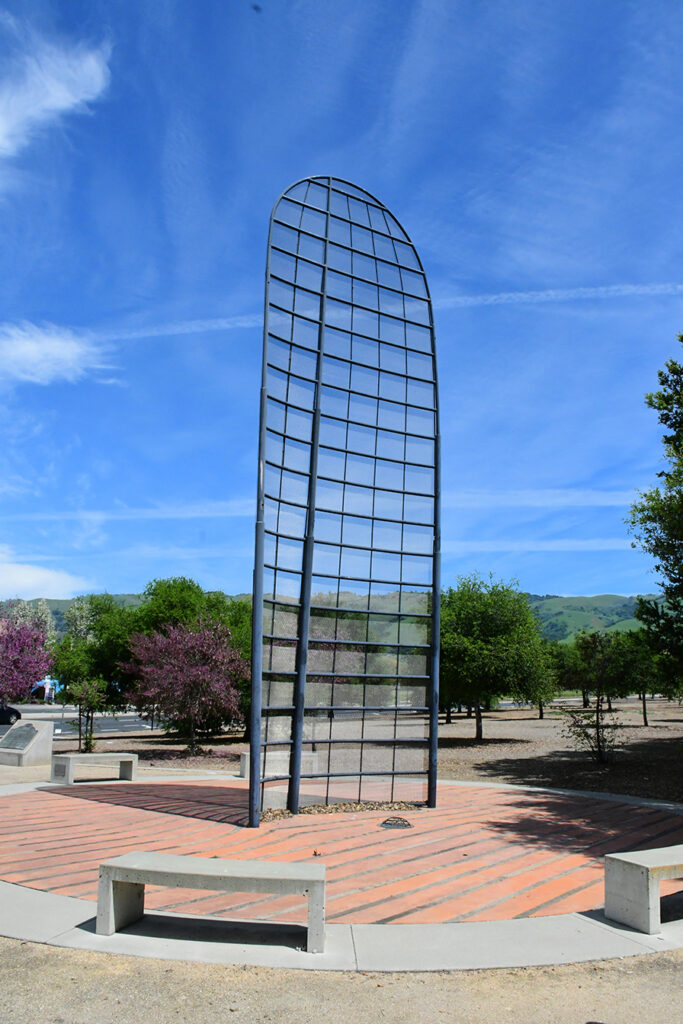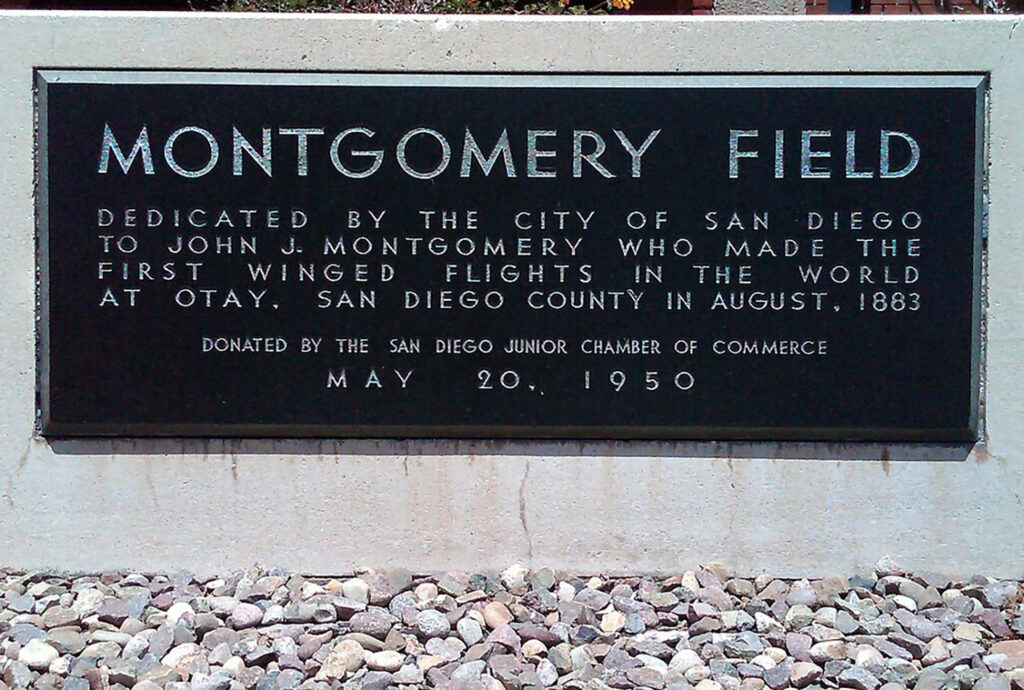Gone but not quite forgotten—the legacy of John J. Montgomery—(part 2)

Although sidelined by history, there are a good number of places where the local aviator, John J. Montgomery’s legacy is preserved including several sites in the Bay Area.
Historic Markers: Two California Historical Landmarks are associated with Montgomery:
• Montgomery Memorial at Otay Mesa near the Montgomery-Waller Recreation Center. The site features a 93-foot high stainless steel test wing panel for a Consolidated B-32 Dominator mounted upright and visible for miles—it was dedicated in 1950.
• Montgomery Hill Park in San Jose, adjacent to Evergreen Valley College. The hill was named Montgomery Hill and declared a historic landmark by the County of Santa Clara on September 12, 1966. The marker—Historical Landmark #813—was installed on October 31, 1967 on the day of Montgomery’s fatal crash on the hill. The city of San Jose received the master plan for Montgomery Hill Park in 1979 and now—46 years later—many visitors can be seen enjoying the green grass, spectacular view of the hills and valley, and 1.2 miles of unpaved hiking trails.
Montgomery Plaza, features a nearby monument to Montgomery—the 30-foot-tall steel sculpture of a glider wing, reminiscent of the ones Montgomery was testing, designed by San Francisco artist Kent Roberts. It was installed in 2008 just down the hill at the intersection of San Felipe and Yerba Buena Roads. The sculpture sits on a 32-foot-diameter plaza. A historic marker there bears the inscription: Three-quarters of a mile northeast is Montgomery Hill, site of the 55 successful flights of John Joseph Montgomery’s ‘aeroplane’ that demonstrated aerodynamic developments still indispensable to modern aircraft. Montgomery combined his engineering skill with the basic principles of aerodynamics that he discovered to produce a heavier-than-air flying machine which had complete control: cambered wing, rear stabilizer, flexible wingtips, and wing-warping aileron.
Evergreen Valley College also honors Montgomery’s memory with a green space (Montgomery Grove), a lecture hall (Montgomery Hall), and an observatory (Montgomery Hill Observatory).
Other Places:
• In 1919, the San Francisco Board of Supervisors changed the name of the Marina Flying Field just east of Crissy Field to Montgomery Field. The name remained from 1920 to 1944 and served as an airmail facility. It is now known as Marina Green.
• On May 20, 1950, the former Gibbs Field, an airport, 6 miles north of San Diego, was renamed Montgomery Field in honor of Montgomery. The airport was renamed Montgomery-Gibbs Executive Airport in 2016, and is one of the busiest general aviation airports in the world. The 456-acre airport has three runways and three helipads. In 2023 a replica of the Santa Clara glider, on loan from the San Diego Air and Space Museum, was installed in the lobby of the Crownair Aviation building at the airport.
• There are five San Diego area elementary schools that bear Montgomery’s name, as well as the Montgomery-Waller Recreation Center near the location of his first glider tests at Otay Mesa.
• A granite obelisk was dedicated in 1946 at Santa Clara University commemorating the 1905 flight of the “Santa Clara” glider launched from 4,000 feet above the campus.
Also an engineering building was dedicated in 1924 as the Montgomery Laboratories; however, that building is now gone.
• In 1949, a section of what is now part of the Interstate 5 freeway that passes through the former site of the Montgomery 1880s Fruitland Ranch—on a stretch of road from the Mexican border to downtown San Diego—was named the John J. Montgomery Freeway.
Museums:
• In 2016, the San Diego Air & Space Museum established an exhibit for John J. Montgomery in its main rotunda, including The 1911 Evergreen glider and Montgomery’s original Soaring Flight manuscript from 1896. Montgomery was inducted into the International Air & Space Hall of Fame in 2017 at the museum.
The Evergreen glider still exists and was displayed in the Dawn of Flight Gallery at the San Diego Air & Space Museum in Balboa Park (an affiliate of the Smithsonian Institute). Currently not on display, the glider is now in storage.
• On April 5, 2008, a celebration of the 125th anniversary of John Montgomery’s first glider flight took place at the Hiller Aviation Museum in San Carlos, California. A full-scale model of this machine is in this museum at the San Carlos Airport just off of Highway 101.
• On March 19, 2005, Montgomery was the focus of a Centennial Celebration of Soaring Flight, held in Aptos, California at the location of some of his early glider trials. At this celebration, a marker was placed there in honor of the first manned high-altitude flights. The inscription on the marker reads:
First High Altitude Aeroplane Flights March 1905
One hundred years ago, in the skies above this monument, three soaring flights were made on March 16th, 17th and 20th, by an aeroplane-glider flown by Aeronaut and parachute daredevil, Daniel John Maloney, which had been designed and built by Professor John J. Montgomery.
The frail craft, weighing only 42 pounds was constructed of spruce, wire, and fortified canvas and had tandem wings with a 24 ft. wingspan and a four-sided tail. It was taken aloft here at the then Leonard Ranch by a smoke-balloon rented by Fred Swanton and owned by Frank Hamilton, to heights of 800 ft., 1,100 ft., and 3,000 feet. The longest flight lasted over 18 minutes and covered over 2 miles. From a letter by Prof. Montgomery to his mother…
“…my machine flew three times, each time better than the other and descended beautifully, going in different directions under perfect control of the aeronaut and landing in a spot selected by him as gently as a feather.”
These flights were the result of 22 years of experimentation and flight testing by Professor Montgomery, beginning with his first glider flight in 1883 at Otay Mesa near San Diego and ending with his accidental death in 1911.
Called the “Father of Basic Flying,” his successes and contributions to the development of flight were heralded by the world’s press at the time, but are now largely forgotten.
Dedicated March 19,2005
Awards:
John J. Montgomery was inducted into the National Aviation Hall of Fame in 1964, U.S. Soaring Hall of Fame in 2001, California Aviation Hall of Fame in 2015, and International Aerospace Hall of Fame in 2017.
The National Society of Aerospace Professionals and the San Diego Aerospace Museum established a John J. Montgomery Award for aerospace excellence in 1966. Members of the X-15, Mercury, and Polaris programs received the award, including Neil Armstrong and other astronauts.
In 2023, the American Society of Mechanical Engineers established an annual John J. Montgomery Award for Distinguished Innovation in Aerospace.
Books
You can read more about Montgomery in the book Quest for Flight, John J. Montgomery and the Dawn of Aviation in the West, by Craig S. Harwood and Gary B. Fogel.
Movies
Glen Ford played John Montgomery in a 1946 film called “Gallant Journey.”
The Roots of Evergreen series will be published the third week of each month and posted in the Online Villager. The next article will feature the architectural pedigree of the Wehner mansion.




